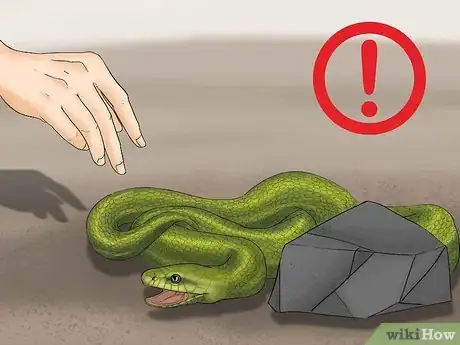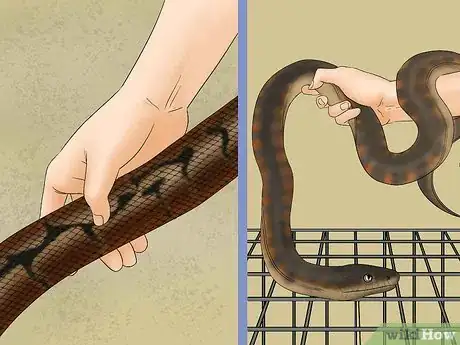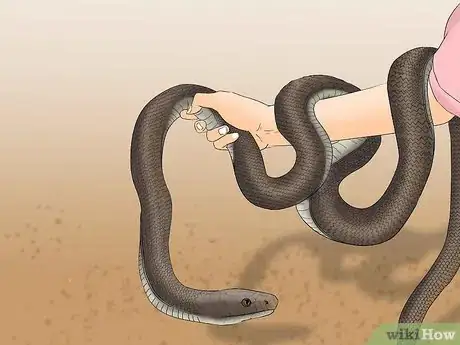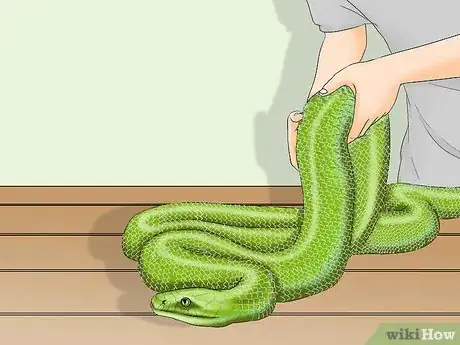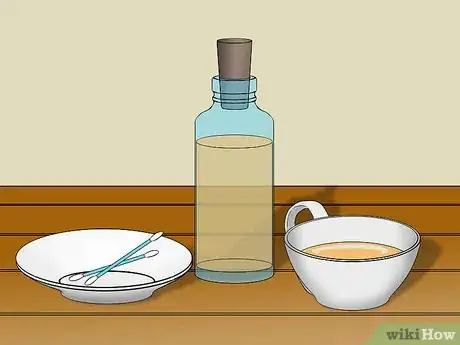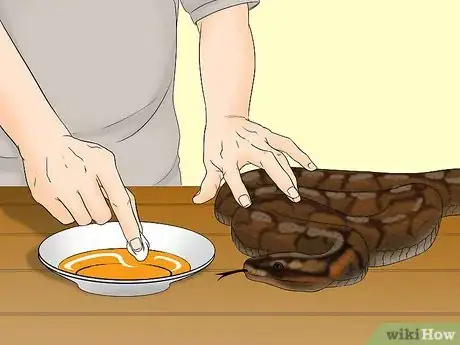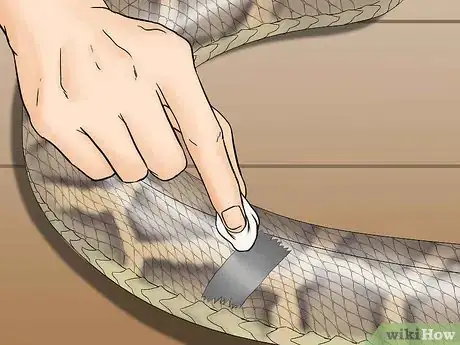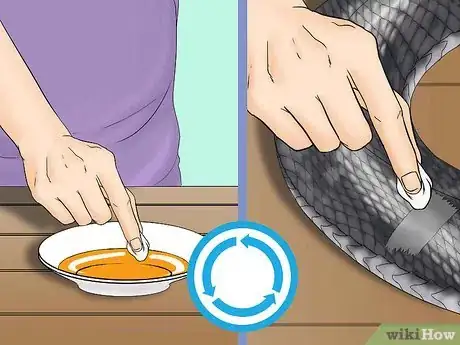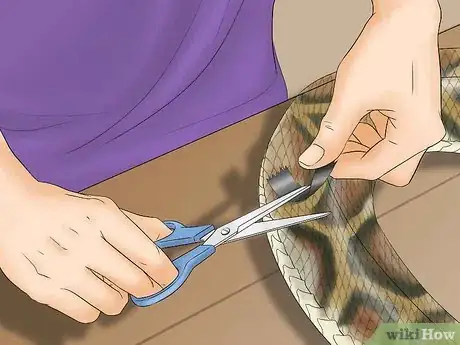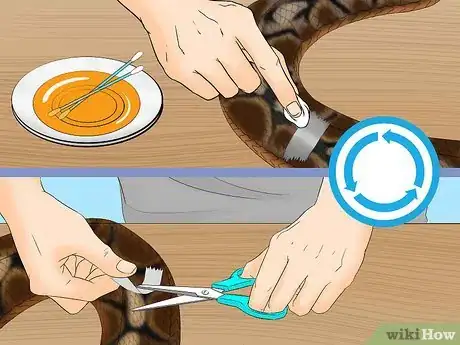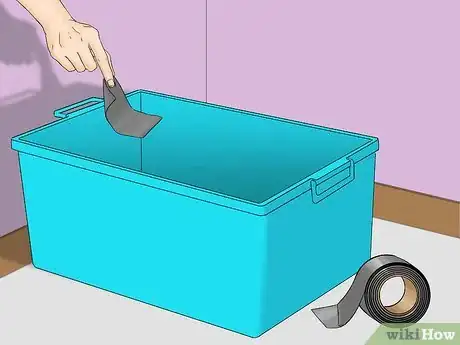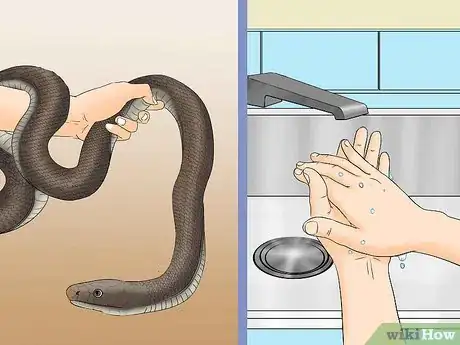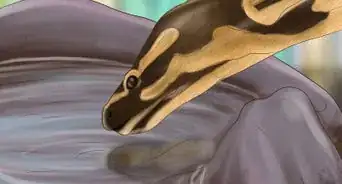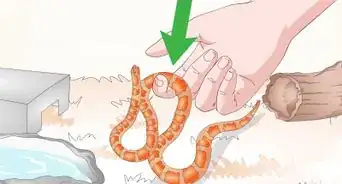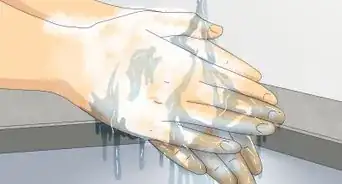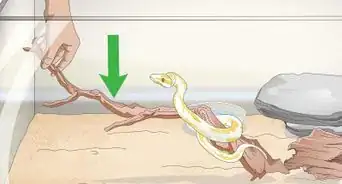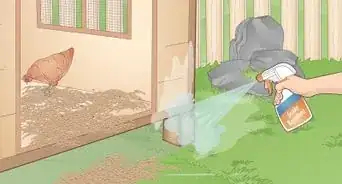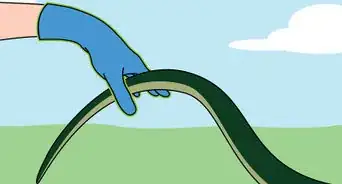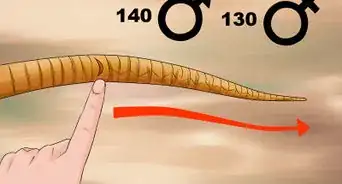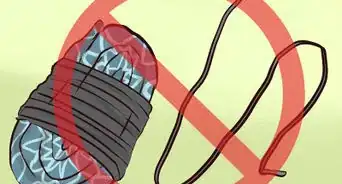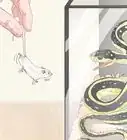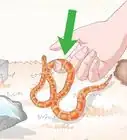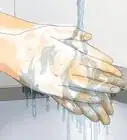This article was co-authored by wikiHow Staff. Our trained team of editors and researchers validate articles for accuracy and comprehensiveness. wikiHow's Content Management Team carefully monitors the work from our editorial staff to ensure that each article is backed by trusted research and meets our high quality standards.
There are 13 references cited in this article, which can be found at the bottom of the page.
wikiHow marks an article as reader-approved once it receives enough positive feedback. In this case, 93% of readers who voted found the article helpful, earning it our reader-approved status.
This article has been viewed 63,264 times.
Learn more...
Snakes can get into all sorts of things, including duct tape! If your snake has duct tape sticking to its body, then you will need to take great care to avoid harming the snake's delicate skin and scales. Use a lubricant to help release the adhesive, and only pull away a small amount of tape at a time.
Steps
Picking up the Snake
-
1Avoid handling a snake that you’re not familiar with. Is this a pet snake you're familiar with handling? Is this a garden snake that you're absolutely certain is non-venomous? If the snake is unknown to you or is venomous, get help from a professional snake handler or reptile veterinarian and do not touch the snake![1]
- Even if the snake is a pet or a non-venomous garden snake, if you don't know how to handle snakes safely, find someone who does. Improper handling of a snake will usually result in the snake biting in self-defense.
-
2Pick up the snake by grasping the middle of its body. Never pick up a snake by its head or tail! Reach into its enclosure and place your fingers under its belly near the middle of its body. Do not squeeze the snake tightly as you do so. Keep a firm but gentle grip to allow the snake to propel itself forward slightly in your hands.[2]
- If you have a snake hook, you may also use that to pick up your snake. Slide the hook under the middle of your snake's body, lift it up, and then transfer the snake to your hand. Snake hooks are useful for picking up your snake when it is active and it may also help to prevent a bite, since snakes sometimes mistake hands for food.
Tip: Avoid picking up your snake when it is hungry and after it eats. Your snake may mistake your hand for food when it is hungry and want to be left alone after eating its food.
Advertisement -
3Hold the snake gently around the back 1/3 of its body. Snakes may seem tough, but they require gentle handling just like any other animal. Support the back 1/3 of your snake’s body by wrapping it around your non-dominant hand or arm. Do not try to control the snake's head or restrict its movement.[3]
-
4Place the snake on a surface. You will need your dominant hand to work on the tape, so let the snake move around on your lap or on a flat surface. Use a sturdy surface, such as a table or countertop, especially if the snake is large.[4]
- It may be a good idea to have 2 people perform this task, so that 1 person can work on removing the duct tape while the other person holds the snake in place. Having someone else available to help will also be essential if the snake gets loose or bites 1 of you in the process.
Loosening the Tape with Oil
-
1Pour 1 fl oz (30 mL) of vegetable or corn oil into a small cup or dish. You'll also need some cotton buds or swabs (Q-tips). Spray or liquid vegetable oil will work, just spray the oil into a small container first, so that you can dip the cotton swabs into it.[5]
- Vegetable or corn oil from your pantry is your best bet. Do not use essential or fragrance oils; these are not edible and might kill the snake.
- If you do not have any vegetable or corn oil, then a bit of baby oil or room temperature butter or bacon grease will also work. Just make sure that the butter or grease is cool before using it or it may burn your snake.
-
2Apply the oil to the tape's sticky side using the cotton swab. Dip the cotton swab into the oil. Make sure that the cotton is completely soaked in the oil. Identify part of the tape that you can insert the swab under and get at the sticky side of the tape. Run the swab along the edge of the tape's sticky side, right where it meets your snake’s skin.[6]
- If needed, gently peel a small amount of the tape away from the snake’s skin so that you can get at the sticky part of the adhesive.
-
3Work the oil under the duct tape's edges to loosen the adhesive. Rotate the swab quickly and gently, to try to work the oil under the tape and lift up the duct tape as you go. The goal is to get oil onto the sticky side of the duct tape to release its hold from the snake's skin, bit by bit. As the oil releases the sticky hold of the tape, the tape will begin to release itself from the skin.[7]
- Avoid pulling at the tape unless it is obvious that the tape is clear of the snake's skin. Pulling too hard may hurt the snake's scales and skin.
-
4Continue to rub the oil onto the tape. Work gradually to release the tape at its edges, only pulling if the tape comes away easily. If there's excessive resistance to the tape, or you feel that removing a section of the tape may hurt the snake, then use more oil. Do not pull at the tape![8]
- Replace the cotton swab as you go. It will gather adhesive from the tape and may become less effective.
-
5Use a small pair of safety scissors to cut off excess tape. This will help to keep the tape away from your snake’s skin, prevent it from getting restuck, and stop it from sticking to new areas of the snake’s body. Take extra care not to cut the skin as you are cutting off the excess duct tape.[9]
- Safety scissors have dull, rounded tips, so they are less likely to nick or cut your snake’s skin.
Tip: You can purchase safety scissors in the first aid section of a drug or grocery store.
-
6Repeat the process until the tape is completely removed. If there is a lot of tape, you may need to try this in several goes. It is better to take the tape off slowly over a few turns than to cause the snake pain or harm it.[10]
- You may even space out these sessions over a few days to remove the tape. As long as you cut off the excess, you snake will not be in danger of getting the tape stuck on its body again.
- Make sure there is nothing in the snake's enclosure that it can get caught on.
Cleaning off Your Snake
-
1Assess the snake's skin for injuries. Once you have removed all of the tape from the snake, check for any cuts, missing scales, or tears that may have been caused by pulling off the tape. If you spot a minor injury, such as a small cut or a missing scale, then watch it over the next few days. If it begins to look red, puffy, or inflamed, then take your snake to see a veterinarian.[11]
-
2Wipe away the excess oil from your snake’s body. The snake will still have oil on it after you finish removing the tape. Wipe the excess oil away gently with a paper towel. Any oil that is left on your snake will soak in or come off on its own after a few days.
- If desired, place a dish of warm water into your snake’s enclosure that is large enough for your snake to fit into. This will allow it to soak and some of the oil will come off in the process.[12] Then, work a few drops of dish soap into a lather with your hands or a cotton ball and gently wipe the snakes body. Rinse the soap away with 80 °F (27 °C) water after you do this.
-
3Remove any duct tape from your snake’s area to keep it safe. If you leave the duct tape in place, then there is a risk of your snake getting into it again. Find safe alternatives to the tape to keep bowls, feeding tubes, and other items in place.
- If you do use duct tape, then ensure it is not accessible to the snake.
Wondering what else you can do to keep your pet snake healthy and happy? There are things you can do to care for your snake in general, take care of it while it is shedding, and feed your snake the types of food it likes.
-
4Wash your hands after handling the snake. Snakes can carry parasites and bacteria that are harmful to humans, such as salmonella, leptospirosis, and campylobacter. You may also contract botulism, ticks, and worms from handling a snake and not washing your hands after. To ensure your safety, wash your hands immediately after handling the snake.[13]
- You should also wash any surfaces that you place the snake on to clean it, such as a tabletop or counter. Spray the area with a bleach cleaner or other antibacterial cleanser and wipe it thoroughly.
- Never wash the snake in an area that is for food preparation, such as on a kitchen counter.
- Use only dedicated containers to clean your snake and wash them with a bleach solution or powdered bleach after you finish.
Community Q&A
-
QuestionWhat if the duct tape rips his skin, do I need to take him to the vet or will he be okay?
 CourtneyLaurenCommunity AnswerIt depends on how bad the rip is. I would take the snake in, just to be on the safe side.
CourtneyLaurenCommunity AnswerIt depends on how bad the rip is. I would take the snake in, just to be on the safe side. -
QuestionMy snake laid on some tiles and it has the glue on its skin. How do I remove the glue?
 Community AnswerSoak it in warm water, then try to gently peel it off.
Community AnswerSoak it in warm water, then try to gently peel it off. -
QuestionI have a Velcro temperature and humidity gauge in my snake's tank. During the night, my snake climbed on it and got the whole thing stuck to her head! I got it off but there is still sticky residue on her head. What do I do to get the residue off?
 Community AnswerUsing damp cotton buds or tissue, gently wash the areas where the residue is present. Only use water. Do not use soap. Do not wake her up or hold her down as this will stress her out. If she repeatedly attempts to bite you then leave her alone. There is a possibility she will get rid of it herself during her next shed.
Community AnswerUsing damp cotton buds or tissue, gently wash the areas where the residue is present. Only use water. Do not use soap. Do not wake her up or hold her down as this will stress her out. If she repeatedly attempts to bite you then leave her alone. There is a possibility she will get rid of it herself during her next shed.
Warnings
- Just pulling tape straight off the snake can pull off large portions of your snake’s skin; if this happens, the snake will likely die.⧼thumbs_response⧽
- Tape that contains fabric thread may be harder to remove. Seek veterinary assistance to avoid pulling the snake's scales off.⧼thumbs_response⧽
- Do not allow a snake around children under the age of 5. Snakes and other reptiles pose a hazard to children because of the bacteria snakes carry.[14]⧼thumbs_response⧽
Things You'll Need
- Cotton swabs (Q-tips)
- Vegetable oil (liquid or spray)
- A small dish or cup
- Safety scissors
- A clean paper towel
References
- ↑ http://ufwildlife.ifas.ufl.edu/safely_dealing_with_snakes.shtml
- ↑ http://www.reptileknowledge.com/news/how-to-handle-a-pet-snake-handling-tips-for-beginners/
- ↑ https://www.youtube.com/watch?v=6hdXsXu6pKQ&feature=youtu.be&t=20
- ↑ https://www.youtube.com/watch?v=S5qLQBc0RMY&feature=youtu.be&t=70
- ↑ https://www.youtube.com/watch?v=S5qLQBc0RMY&feature=youtu.be&t=86
- ↑ https://www.youtube.com/watch?v=S5qLQBc0RMY&feature=youtu.be&t=99
- ↑ https://www.youtube.com/watch?v=S5qLQBc0RMY&feature=youtu.be&t=109
- ↑ https://www.youtube.com/watch?v=S5qLQBc0RMY&feature=youtu.be&t=113
- ↑ https://www.youtube.com/watch?v=S5qLQBc0RMY&feature=youtu.be&t=135
- ↑ https://www.youtube.com/watch?v=S5qLQBc0RMY&feature=youtu.be&t=125
- ↑ https://www.petful.com/pet-health/snake-skin-problems/
- ↑ https://www.petmd.com/reptile/care/how-bathe-your-reptile
- ↑ https://www.hse.ie/eng/health/child/childsafety/reptiles.html
- ↑ https://www.hse.ie/eng/health/child/childsafety/reptiles.html
About This Article
To remove duct tape from a snake, start by placing the snake on a secure surface. Then, dip a cotton swab in some vegetable oil, and run it along the edge of the tape between the sticky side and your snake's skin. Continue to apply oil along all the edges of the tape, and gently peel up the edges as the adhesive loosens. Avoid pulling on the tape or you could damage your snake's skin. Once all of the tape is off, examine your snake for injuries, and wipe off any excess oil with a paper towel. To learn how to safely pick up your snake, keep reading!
